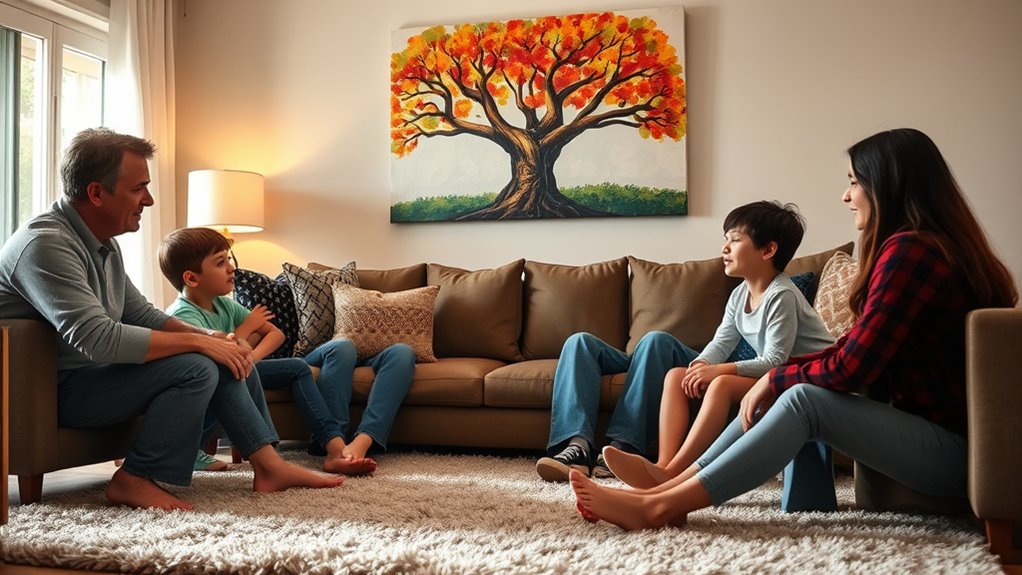Healthy family communication and effective conflict resolution are essential for strong relationships. Understanding your family’s communication patterns and conflict styles can enhance interactions. Embracing emotional expression and practicing cognitive flexibility helps you navigate disagreements with empathy. Parenting styles play a significant role in shaping these dynamics, and regular family gatherings can foster open dialogue. Viewing conflict as an opportunity for growth can strengthen bonds. Discover more strategies for improving your family communication and conflict resolution skills.
Key Takeaways
- Encourage open dialogue and active listening to foster effective communication and understanding among family members.
- Utilize “I” statements for clear expression of feelings, reducing blame and promoting constructive discussions.
- Approach conflicts collaboratively, viewing them as opportunities for growth and mutual understanding.
- Regular family gatherings and routines create a stable environment that enhances communication and strengthens relationships.
- Prioritize emotional expression and cognitive flexibility to improve conflict management and navigate disagreements thoughtfully.
Understanding Family Communication Patterns

When you explore understanding family communication patterns, you’ll discover how these styles shape relationships and conflict resolution. The Family Communication Patterns Theory identifies four primary styles: consensual, protective, pluralistic, and laissez-faire.
Each style reflects varying levels of conversation and conformity, influencing how family members interact. For instance, consensual families encourage open dialogue while respecting authority, fostering cohesion. In contrast, protective families may suppress discussion, leading to avoidant conflict resolution. Additionally, these four primary styles play a crucial role in determining how families approach disagreements and resolve conflicts.
Pluralistic families thrive on open communication, often resulting in collaborative strategies for resolving disputes. Understanding these patterns is essential as they not only affect family dynamics but also shape how individuals navigate relationships outside the family unit, impacting personal development and social skills.
The Role of Conflict Styles in Family Dynamics

Understanding family communication patterns lays the groundwork for examining how conflict styles operate within family dynamics. Your conflict style, whether avoidant, validating, volatile, or hostile, can greatly influence your emotional well-being and behavior. If you notice that your conflict style mirrors your parents’, it’s likely due to intergenerational transmission. This learned behavior can affect not just family relationships but also your future romantic partnerships. Exposure to destructive conflict can hinder children’s socio-emotional development, while constructive approaches foster growth. By recognizing these patterns, you can actively choose adaptive conflict styles that promote open communication, ultimately improving your family’s dynamics and enhancing overall harmony. Individuals from high conversation families tend to engage in constructive conflict management styles that further support healthy relationships.
Emotional Expression and Its Impact on Conflict Management

Emotional expression plays an essential role in how conflicts are managed within families. When you understand and express your emotions, it can greatly improve conflict resolution. High emotional intelligence helps you navigate situations thoughtfully, rather than reacting impulsively. By managing disruptive emotions and practicing self-regulation, you can maintain clarity during disagreements. Empathy also allows you to appreciate others’ perspectives, enhancing communication. Recognizing emotional triggers helps you respond more effectively, preventing misunderstandings. Positive emotions foster collaboration, while negative ones can escalate conflicts. As a result, expressing emotions constructively creates an environment where everyone feels validated. Additionally, emotional intelligence fosters an environment of understanding and respect despite disagreements.
Cognitive Flexibility in Conflict Resolution

Cognitive flexibility is essential for effectively resolving conflicts within families, as it enables you to adapt your thinking and approach based on the situation at hand. This ability allows you to switch between different perspectives and consider new information, enhancing your problem-solving skills. Engaging in expressive family communication fosters higher cognitive flexibility, which directly influences your conflict resolution strategies. When you embrace adaptability, you’re more likely to employ positive problem-solving techniques, leading to better outcomes. The Family Communication Patterns significantly influence conflict resolution styles, highlighting the importance of effective communication in navigating disagreements. Additionally, being able to recognize emotional intelligence in family members can greatly enhance your ability to resolve conflicts. The prefrontal cortex supports this cognitive flexibility, helping you navigate conflicts efficiently. By developing this skill, you not only improve your family interactions but also boost your overall well-being, making conflict resolution a more constructive process. Understanding the stages of emotional and psychological growth can also provide valuable insights into family dynamics during conflicts.
The Influence of Parenting Styles on Family Communication

Effective conflict resolution in families often hinges on the communication styles shaped by parenting approaches. If you practice authoritative parenting, you’re likely fostering open dialogue, which encourages your children to express themselves and enhances negotiation skills. This open communication creates a supportive environment where everyone feels heard.
In contrast, authoritarian parenting may lead to stricter communication patterns, discouraging children from resolving conflicts actively. This can leave issues unresolved.
On the other hand, permissive parenting can result in poor self-regulation, affecting how children handle disputes.
Ultimately, your parenting style greatly influences your family’s communication dynamics and conflict resolution strategies, shaping how children learn to navigate challenges in their relationships.
Social Media’s Role in Family Interactions

As families increasingly turn to social media for communication, the dynamics of their interactions are evolving. While platforms can help maintain connections across distances, they can also reduce face-to-face interactions.
You might notice family members phubbing each other during gatherings, leading to strained bonds. Excessive screen time can distract from quality moments together, so it’s vital to set limits. Engaging in offline activities can strengthen your family ties.
Open discussions about social media use promote understanding and reduce potential conflicts. Remember, using social media for educational purposes can enrich interactions, while teaching digital safety guarantees healthy engagement.
Balancing online and offline communication is key to fostering strong family relationships in today’s digital age.
Cultural Factors Shaping Communication and Conflict

Cultural factors greatly shape how families communicate and resolve conflicts, impacting relationships at every level. In many traditional families, cultural norms emphasize obedience and emotional restraint, which can limit open dialogue.
Hierarchical communication patterns reflect respect and authority, often hindering younger members from expressing their thoughts freely. You might notice that generational differences lead to varied emotional expressiveness, affecting how conflicts are approached.
Ethnicity, religion, and gender also play significant roles; for instance, male headship can influence communication dynamics. As younger members lean towards direct communication styles, older generations may prefer indirect methods.
Balancing traditional values with modern communication can help you navigate these differences, fostering stronger family connections and healthier conflict resolutions.
Strategies for Promoting Healthy Family Communication

Steering communication and conflict in families requires intentional strategies that foster healthy interactions.
Start with active listening; truly hear what others say by maintaining eye contact and using nonverbal cues. Reflective listening helps by repeating back what you understood. Incorporating active listening techniques can significantly enhance your family’s communication dynamics.
Clear communication is essential—express your thoughts clearly and use “I” statements to convey feelings without placing blame. Practice empathy and recognize nonverbal cues to enhance understanding. Additionally, gentle stretching before family discussions can help relax and open up communication lines. Establishing consistent routines, such as family meals, can also provide a sense of stability and promote healthy family communication. Research suggests that sleep challenges can affect emotional regulation, further highlighting the importance of addressing family sleep habits.
Regular family gatherings create opportunities for connection, while tech-free zones encourage genuine interaction.
Finally, approach conflicts collaboratively, brainstorming solutions that satisfy everyone’s needs. These strategies help cultivate a supportive atmosphere where open discussions thrive, strengthening your family bonds and improving overall communication. Additionally, consider integrating sleep training methods that promote better rest for all family members, as sleep quality can significantly impact family dynamics.
Viewing Conflict as an Opportunity for Growth

While conflict might feel uncomfortable, it can actually serve as a valuable opportunity for growth within families. When you face disagreements, they can spark important discussions that enhance understanding and communication.
Engaging in conflict often uncovers unaddressed needs among family members, fostering deeper emotional connections and developing empathy. Successfully managing disagreements builds resilience, teaching everyone how to manage stress and respond positively to challenges.
Clear communication during these moments helps prevent misunderstandings, while regular family meetings create a safe space for open dialogue. By embracing conflict as a natural part of relationships, you prepare your family to tackle challenges healthily, ultimately reinforcing shared values and goals.
This proactive approach promotes emotional maturity and strengthens family bonds.
Frequently Asked Questions
How Can I Identify My Family’s Communication Pattern?
To identify your family’s communication pattern, start by observing how conversations flow. Notice if discussions are open or if decisions are mostly made without input.
Think about how much authority shapes your family’s interactions. Do you feel comfortable sharing opinions?
Assess if the focus is on obedience or if everyone’s encouraged to express themselves. Reflect on these dynamics to determine if your family leans towards consensual, pluralistic, protective, or laissez-faire communication styles.
What Signs Indicate a Healthy Family Communication Style?
You can spot a healthy family communication style by noticing how openly everyone expresses their thoughts and feelings.
If family members actively listen to each other without interrupting, that’s a good sign.
When discussions involve mutual respect and understanding, it indicates a positive environment.
Also, if conflicts are resolved calmly and everyone feels valued, you’ve got a strong communication dynamic.
Regular check-ins and shared activities further enhance these healthy interactions.
Can Conflict Resolution Styles Change Over Time?
Think of conflict resolution styles like a tree; they grow and change with time.
Yes, your conflict resolution styles can change over time. As you experience life, you might shift from aggressive approaches to more collaborative ones. This evolution often comes from increased empathy and understanding, allowing you to navigate conflicts more effectively.
How Does Birth Order Affect Family Communication Dynamics?
Birth order considerably impacts family communication dynamics.
If you’re a firstborn, you might take charge and speak assertively, while middle children often seek harmony and avoid confrontation.
As a lastborn, you might use humor to navigate discussions, making interactions lively.
If you’re an only child, you may mirror adult conversations, lacking sibling negotiation skills.
Understanding these tendencies can help you foster better communication within your family, enhancing your interactions and relationships.
What Role Do Extended Family Relationships Play in Conflict Resolution?
Oh sure, let’s throw a family reunion into the mix and expect smooth sailing!
Extended family relationships can complicate conflict resolution like a cat in a dog park. You’ve got differing opinions, unsolicited advice, and boundaries that seem to vanish.
By establishing clear limits and practicing empathy, you can navigate these choppy waters.
After all, a little patience and effective communication might just transform those family feuds into mere misunderstandings.
Conclusion
In managing family dynamics, you might think that conflict spells disaster, but imagine it as a storm that clears the air, leaving behind a fresh perspective. By embracing healthy communication and conflict resolution strategies, you not only strengthen bonds but also foster growth within your family. Remember, every disagreement can be a stepping stone toward deeper understanding and connection. So, lean into those tough conversations—your family’s harmony and resilience will flourish as a result.









